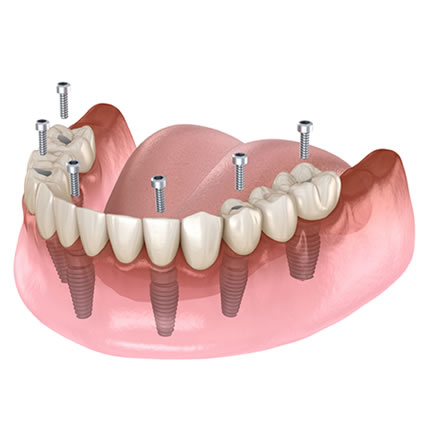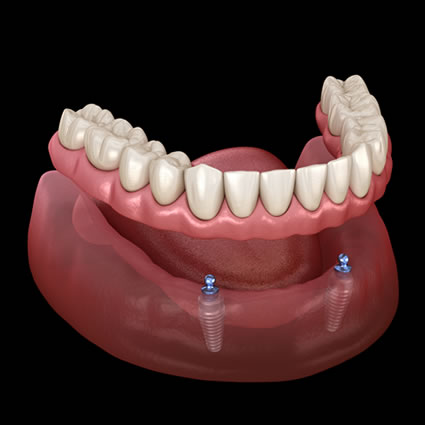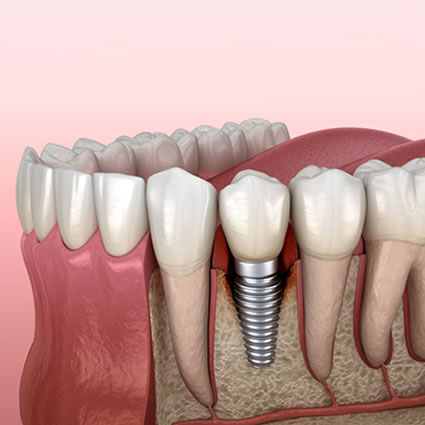Dental Implants
The best method for replacing missing teeth is to install a dental implant. Implants are artificial roots, which support the “crown” portion that’s visible when you smile. They can be used in a variety of applications, from replacing an individual tooth to all of your teeth at once. Various combinations of implant restorations can give you back your entire smile!
How Do Implants Work?
Each dental implant is crafted from titanium, which is a hypoallergenic and biocompatible metal. Since titanium promotes healthy bone integration, implants become permanently fused within 2-6 months after placement.
Implant treatment is essentially painless and minimally invasive. Since they do not alter the healthy teeth next to them, implants are preferred over conventional bridges in most cases.
 Implant Bridge
Implant Bridge  Implant Supported Denture
Implant Supported Denture An implant can support a crown, multi-tooth bridge or even full denture. When installed, the implant is not visible whatsoever. You’ll only see the “tooth” (restoration) on top of it, just as you would a natural tooth.
We prefer to use top implant brands like Straumann, Nobel and Astra Tech (by Dentsply) for several reasons. First, if they ever require maintenance in the future, established brands will be able to provide ongoing replacement pieces. Fortunately, these highly rated brands are known for lasting for 40 or 50 years or more, essentially becoming a lifelong investment. Newly-developed or budget implant brands may not exist decades in the future if you need follow-up care.
Our dental implant candidates typically have exceptionally good home hygiene habits. Broken and decayed teeth are usually restored prior to initiating implant therapy. Since caring for your implants is essentially the same as maintenance of natural teeth, you’ll need to plan on brushing and flossing daily. Six-monthly cleans are also essential. Treat them as you would a natural tooth.
Are you planning to get dental implants but don’t have enough bone to support them? A bone graft can provide the added support around your proposed implant. Grafts also work on certain teeth compromised by bone loss or gum disease.
Grafting essentially covers the exposed portions of the implant or tooth root that do not have enough bone coverage. Rest assured, it’s a common adjunctive procedure to perform alongside implant therapy.
Although grafting has many applications, the concept is the same: mending the volume of bone in a specific space. Reinforcing bony support helps to secure teeth, support implants and even act as a more comfortable base for dentures to rest against.
The maxillary sinus cavity rests directly above our upper teeth on the left and right side of our nose. Whenever a tooth in that area goes missing, the sinus lining can drop as the bone shrinks. If you hope to get an implant, there may not be adequate space or the implant could perforate the floor of your sinuses. Infection and discomfort are avoidable by lifting the sinus floor and placing a bone graft in that location.
During a sinus lift procedure, we elevate the membrane lining and place a bone graft into the open space. Sometimes we can place a graft at the same time as the implant, while others may need 4-6 months in between.
Sinus lifts are carried out by our oral surgeon as it’s a detailed procedure requiring superior training and skill.
Do I Qualify for Dental Implants?
Request a dental implants consultation today to find out!


